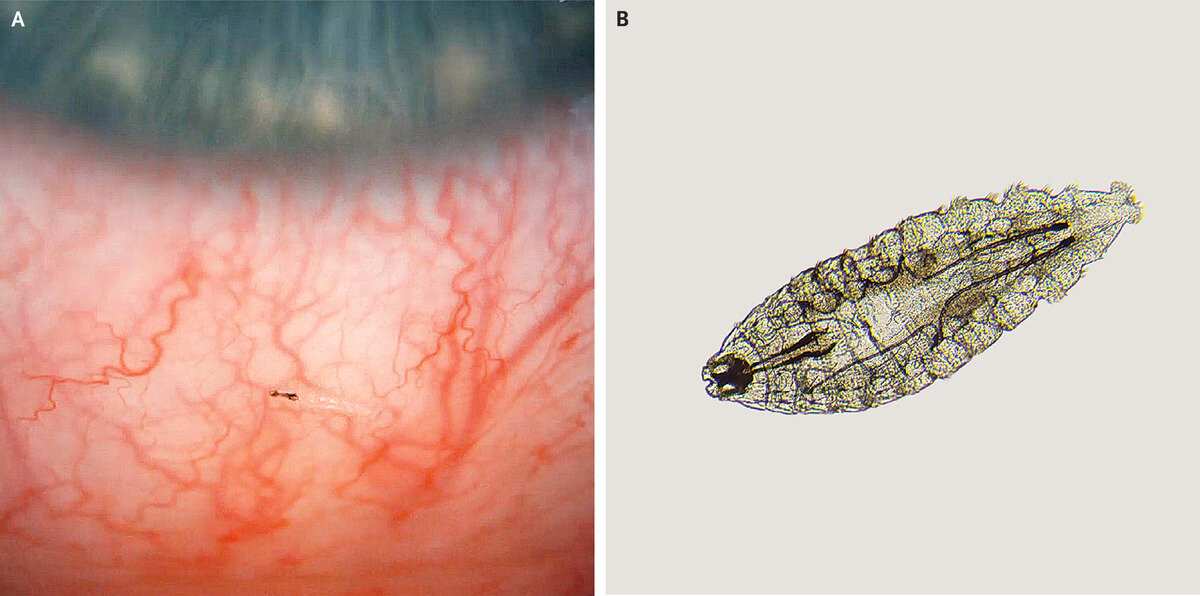A 53-year-old man went to a French emergency room complaining of a persistently itchy eye. He told his medical team that earlier that day while gardening, he had “felt something enter his right eye.”
Upon closer examination, doctors at the University Hospital of Saint-Etienne in Saint-Priest-en-Jarez, France found more than dozen squirming larvae in his eye. Incredibly, the man still had 20/20 vision.
The diagnosis was external ophthalmomyiasis, medical terminology for an infestation of the eye by fly larvae. The infestation had caused dilated blood vessels, a condition known as conjunctival hyperemia.
“In this case, the larvae were removed with forceps and identified as Oestrus ovis, also known as the sheep bot fly, which had presumably flown into the patient’s eye and deposited the larvae,” reported the medical team in the New England Journal of Medicine (NEJM) in an April 7, 2022, report.
But here’s a twist: The gardener does not have livestock on his property. Rather, he told his medical team that his garden was located close to a sheep and horse farm.
Sheep botflies are common in France and found around the world, so long as there are sheep and goats around. Eggs are fertilized, developed, and hatched inside of a mother fly who will then then deposit the living parasitic babies inside of the nasal passages and cavities of domesticated livestock, according to the University of Florida. Depending on the phase of their life cycle, sheep botflies move throughout the nasal passage until they reach a size of about 1 inch. At this point, they travel back to the nostrils awaiting their host’s next sneeze, which catapults them out into the world.
Sheep botflies have also been known to infect deer, and though they aim to infect the noses of their hosts, they will sometimes unintentionally enter the eye sockets of animals and humans. Though perhaps disturbing, such infestations are still relatively rare. Between 1918 and 2017, human infestation has been reported 295 times.
After taking video footage and snapping a few photos, the doctors attending the case above removed the larvae one at a time with tiny tweezers and prescribed antibiotics to prevent infection. During a follow-up visit 10 days later, they found the patient did not suffer any secondary infection or eye damage.
Sources:
Abihaidar, Nicolas, and Thibaud Garcin. “External Ophthalmomyiasis Due to Oestrus Ovis.” New England Journal of Medicine, Apr. 2022. world, www.nejm.org, https://doi.org/10.1056/NEJMicm2115416.
Sheep Bot Fly. https://entnemdept.ufl.edu/creatures/LIVESTOCK/sheep_bot_fly.html. Accessed 11 Apr. 2022.
Yirka, Bob, and Medical Xpress. Gardener’s Itchy Eye Turns out to Be Maggot Larvae Infestation. https://medicalxpress.com/news/2022-04-gardener-itchy-eye-maggot-larvae.html. Accessed 11 Apr. 2022.



More Stories
Join the Online Education Wave: Virtual Preschool Teacher Jobs Open!
Truth For Teachers – Why you need a “to-don’t” list
SkillsUSA Devils Lake brings home 16 medals